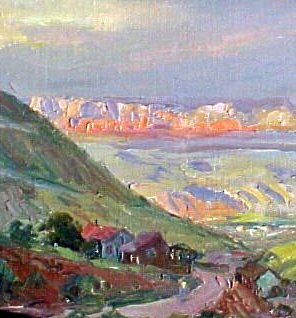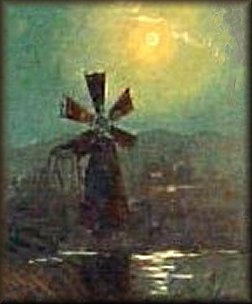

Carolus Verhaeren 1908-1956
Southern California ArtistBorn in 1908 in Belgium, Mr. Carolus Verhaeren came from a family of great energy and creativity. For example, his grandfather was the famous Flemish sculptor Victor Ven, and he was a nephew of Emile Verhaeren, a famous Belgian author. Carolus Verhaeren received his early art training in London and Canada, then came to the US where he lived first in Michigan and later in Southern California.
He chose to paint western desert and woodland scenes, surf and coastline, still-life and portraits. He was featured in one-man shows in Canada, Mexico, and throughout the United States. His work is represented in numerous private collections around the world.
Well-known and respected in La Jolla, California, where he came to live and maintain his studio, he developed the fine tenor of art that has come to represent the La Jolla art community. In 1956 Verhaeren died in Pacific Beach, a beach community of San Diego.
Special thanks to Tom Wallace for identifying the subject of the Verhaeren painting "Near Jerome" featured on this website: "Jerome is an old mining town in the Bradshaw mountains in central Arizona. The red rocks in the scene are the red rock canyons of Sedona, Arizona. The white area in the center depression is Tuzigoot, an old Anazai pueblo. The Verde River flows just the other side of it before the first rise of bluffs. This is a great painting -- you can go there today and see the same view. -- Regards, Tom Wallace."

James T. Harwood 1860-1940
Utah ArtistJ. T. Harwood was born in Lehi, Utah, in 1860. He studied art in college with Utah artists George M. Ottinger and Danquart A. Weggeland. He was so versatile and proficient that he taught oil painting to other excellent artists. In 1888, at the urging of his former teachers, Harwood became the first of a group of Utah-born artists to travel to France and study art in Paris.
While in Paris, Harwood met another American art student, Harriet Richards, and in 1891, he and Harriet were married. In 1892, he became the first Utahn to have a painting displayed in the prestigious Paris Salon. During the next few years, the Harwoods divided their time between a Salt Lake City studio and Paris, where they returned repeatedly for "refresher" experiences. In 1904, the Harwoods returned to settle in Salt Lake City where James taught art in local schools and painted in his studio.
In April of 1921, his beloved Harriet died. Two years later, Harwood became the head of the art department at the University of Utah. He developed an art program which emphasized drawing foundations and craftsmanship that was in evidence long after Harwood was gone.
In December of 1927, Harwood met and fell in love with a young literature student, Ione Godwin. Their relationship was considered scandalous because of the age difference of 47 years, but on June 1, 1929, they married. Harwood found in Ione the inspiration to begin a re-energized period of work. At 70, Harwood resigned from the University of Utah and took his family to Paris once again, where he painted, made prints, and participated in exhibits at the Salon. Over the next nine years, Harwood's art became recognized not only at home but also in the art museums of Europe. He remained in Europe until 1939, when the threat of war sent the Harwoods home to Salt Lake City, where he died in October of 1940.
The offering from this collection consists of an artist's advertisement for art classes, contained in a charming miniature oil painting of a windmill. At one time the piece was discarded, and was rescued from oblivion by a teenager who discovered and rescued it for posterity.

Minerva Teichert 1888-1976
Mormon Woman ArtistMinerva Kohlhepp Teichert (1888-1976) started painting as a very young girl. Her earliest works demonstrated an incredible ability to paint and draw animals,and it was clear she knew how to draw them from any perspective and direction.
At the Art Institute of Chicago she learned how to draw from John Vanderpool, a great American draftsman. Her "painterly, looser style" evolved with her Art Students League studies with Henri.
"She gave her murals just enough detail to give the gist of the story and then she is finished," said Dawn Pheysey, art curator. "When the story is done, the story is done.
Not long after, she left to live near the Utah and Idaho border to marry her "cowboy sweetheart" and to raise five children in the tiny community of Cokeville, Wyoming. She worked in the fields, nurtured her family -- and painted nearly every day of her life until her death in 1976.
"I must paint," she wrote. "It's a disease."
Once Teichert returned to the West, her formal studies ended, but she continued to read art books voraciously, and studied National Geographic magazines to give her ideas about architecture, costuming and culture.
"What she accomplished was pretty incredible," Pheysey said. "In Cokeville, there was no one to bounce ideas off from and no contact with the outside world, but her voice sang clearly anyway."
Her art provided a means of telling people about her faith in Christ and her church, the Church of Jesus Christ of Latter-Day Saints. Concurrent with her religious themes, she interpreted tales of the Western colonization by the Mormon pioneers. She frequently shared her gift with friends and neighbors by giving paintings as presents for weddings and funerals.
From her living room, Teichert mothered her children, ran the household and painted. The result was more than 500 paintings and a lifelong commitment to painting that extended into her 80s. She was a particularly skilled muralist, and was commissioned by her church to paint interior murals on all four walls of the world room in the majestic LDS Temple in Manti, Utah.
"As we look at her style of painting, we can see that the way she approached her subject matter and the kind of research she did for her work helps us understand she deserves a national place in the history of art. We have a strong commitment to think that through and do the scholarly work that will help her find a significant place in the world of art," said Campbell Gray, director of the BYU Museum of Art.

